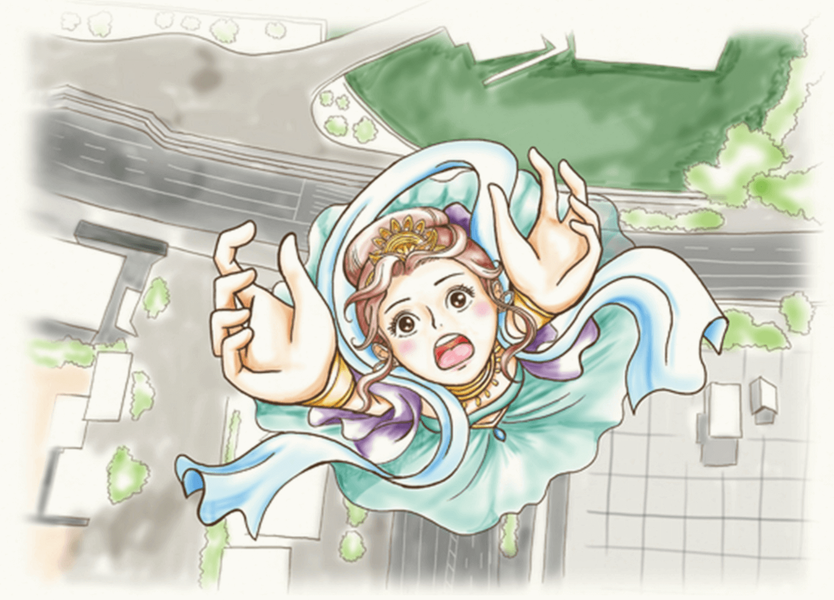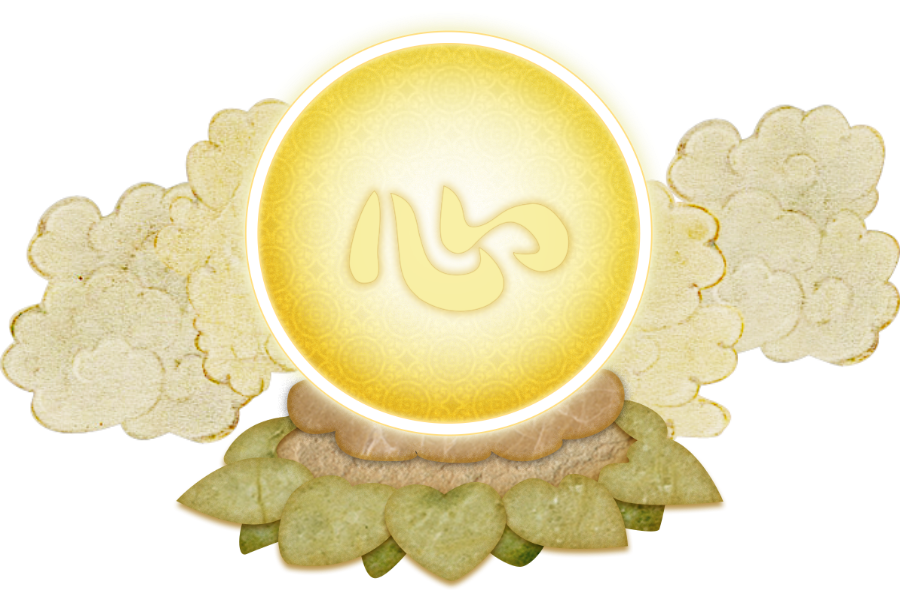ここから本文です。

- TOP
- Digital Museum
- Maya's Journey Home
- MAYA’S WORLD
- Kumano kanshin jukkai zu (Kumano Ten-Worlds Mandala)




Kumano kanshin jukkai zu (Kumano Ten-Worlds Mandala)
This mandala depicts the Buddhist universe, encompassing all the realms of reincarnation and satori (awakening or liberation from the cycle of death and rebirth). The basic structure of the painting consists of the kanji character 心 (heart) in the center; the Stairway of Life; the Six Realms; and the Four Worlds of Buddha, Bodhisattva, Shomon (hearing the calling) and Engaku (attaining satori). These Six Realms and Four Worlds are collectively referred to as the Ten Worlds. The ten worlds and the character for “heart” are linked with red lines, and the boundaries between the ten worlds and between life and death are depicted with torii shrine gates, hinting at how people’s hearts or their actions determine what realm they will end up in after death. Mandalas of this type were popular from the Sengoku Period (1467-1603) through the early modern era, and were employed in explanations of Buddhist principles by missionary nuns known as Kumano bikuni (affiliated with the Kumano religious complex in present-day Wakayama).
Explanation of all figures
Chapter 1 The Realm of Humans
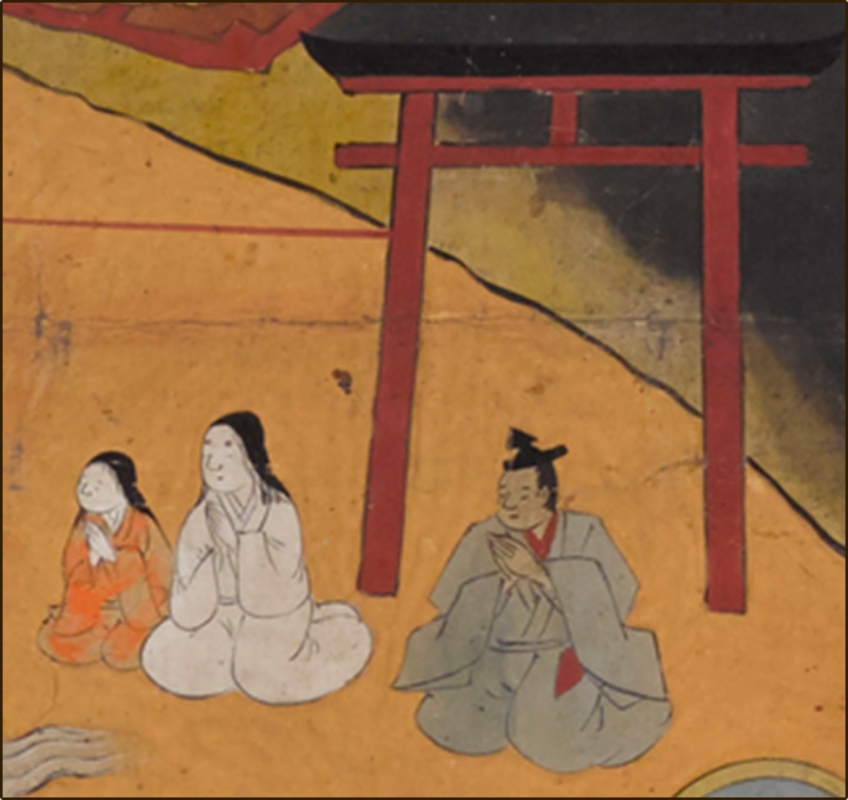
The Realm of Humans is this realm of our human. It is believed that impurity, suffering, and impermanence are full in there. According to the influential text Ojoyoshu (Essentials of Rebirth in the Pure Land) by the Buddhist scholar Genshin, who lived around 1,000 years ago, the Realm of Humans has three key states, Impurity, Suffering, and Impermanence. In this painting, the Realm of Humans is symbolized by three people who appear to be a family: a samurai, his wife, and a child. Meanwhile, on the Stairway of Life, there are graphic depictions of the four varieties of Suffering (birth, aging, death, and sickness, with the last represented by a demon atop a cloud and a people held captive.) A corpse in a graveyard being devoured by birds and dogs hint at the fact that all human beings must perish (Impermanence) and at the Impurity of the body. The story focuses in particular on the Suffering aspect of human existence (the four, or eight, varieties of suffering).
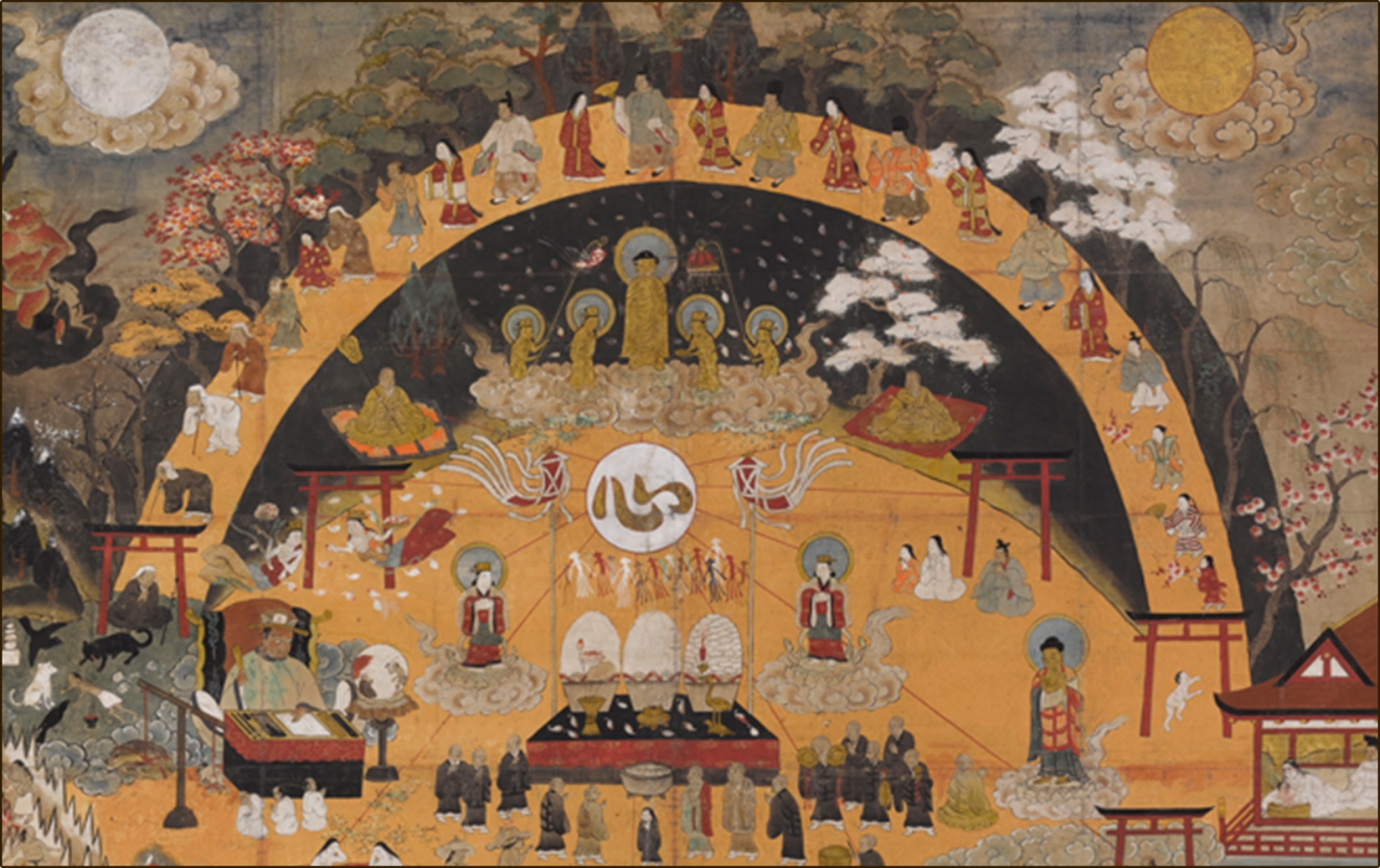
Chapter 2 Realm of Realm of Animals
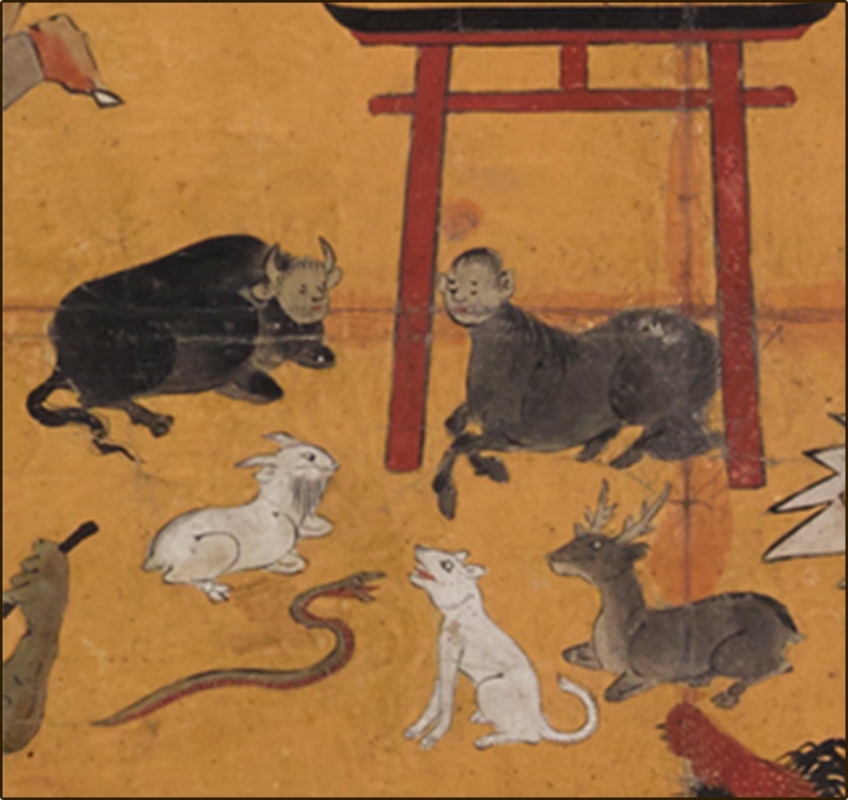
The Realms of Animals has all sorts of animals and birds along with insects. Genshin’s Ojoyoshu (Essentials of Rebirth in the Pure Land) describes the Realm of Animals as one where “creatures mutually inflict suffering upon one another.” In this painting, familiar as livestock and the target of hunting, cows, horses, snakes, rams, bucks, and roosters. The cow and horse with human faces imply that humans have been reincarnated as animals. The story focuses in particular on the merciless aspect of the natural world, where the weak are devoured by the strong.
Chapter 3 Realm of Constant War
The Realm of Constant War means the heaven of Asura who should always battle with Indra, Taisyakuten. Ojoyoshu (Essentials of Rebirth in the Pure Land) states that “When it thunders these creatures [Asura, or ‘angry demons’] are in great confusion, for they think it is the attacking drum of Heaven and their hearts are in great terror and pain.” The painting depicts the “attacking drum of Heaven,” and symbolizes the Realm of Constant War with warlords murdering one another and samurai committing seppuku ritual suicide. The story portrays the battle between the Asura and Deva (deities), drawn from mythology that actually predates Buddhism.
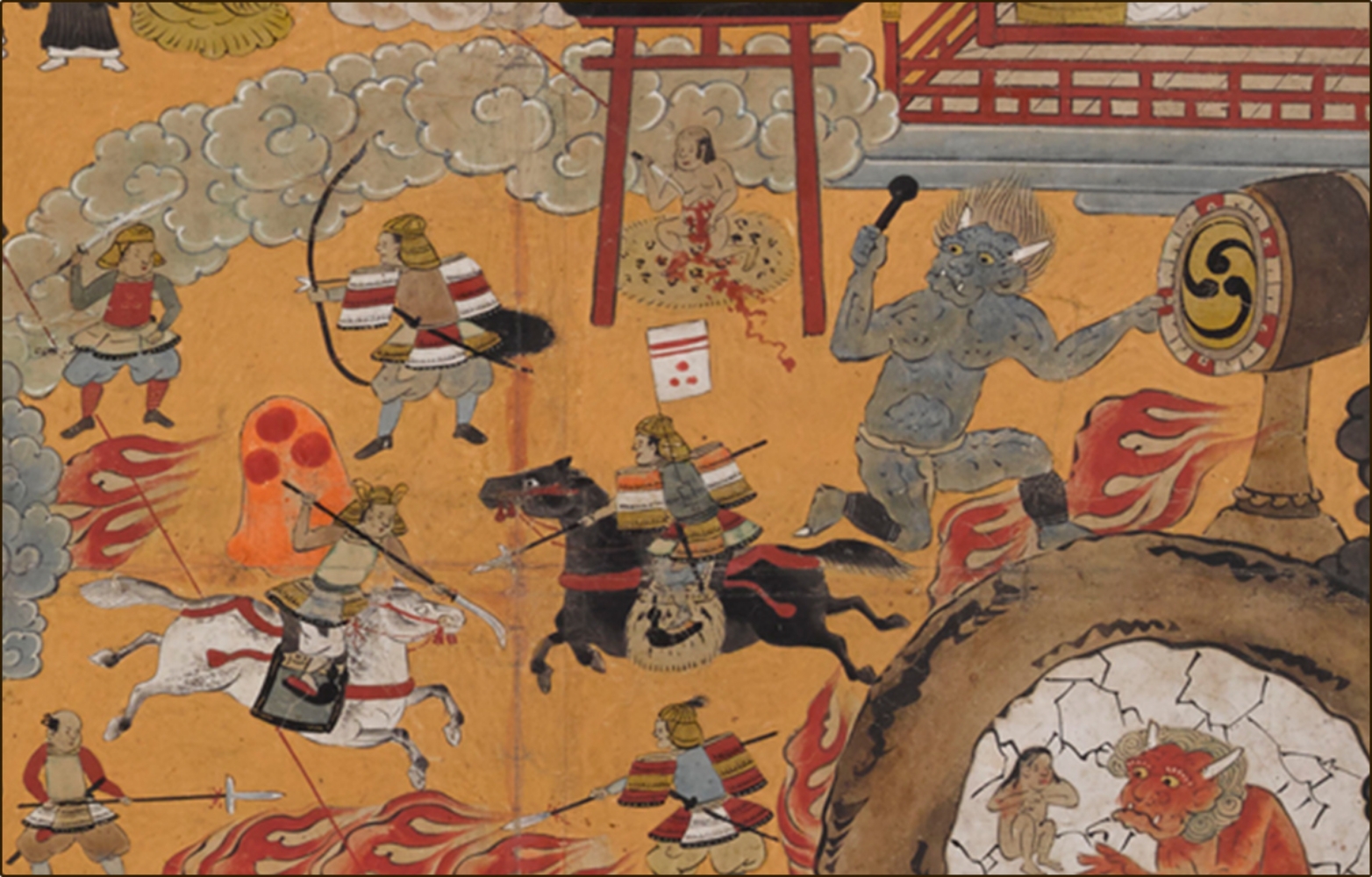
Chapter 4 Realm of Hungry Ghosts

The Realm of Hungry Ghosts is the name for the world of beings suffering from hunger and thirst extremely. Ojoyoshu (Essentials of Rebirth in the Pure Land) states that people consumed by greed or envy fall into the Realm of Hungry Ghosts, and describes a wide variety of these ghoulish spirits. The painting shows three types of hungry ghosts, who are unable to eat from bowls of rice, unable to drink water from a river, and unable to consume fruit, because all of these are on fire. In this painting, all hungry ghosts are miserably naked, besides very thin and protruding their belly. In the story, the hungry ghosts unable to drink water make an appearance.
Chapter 5 Realm of Hell
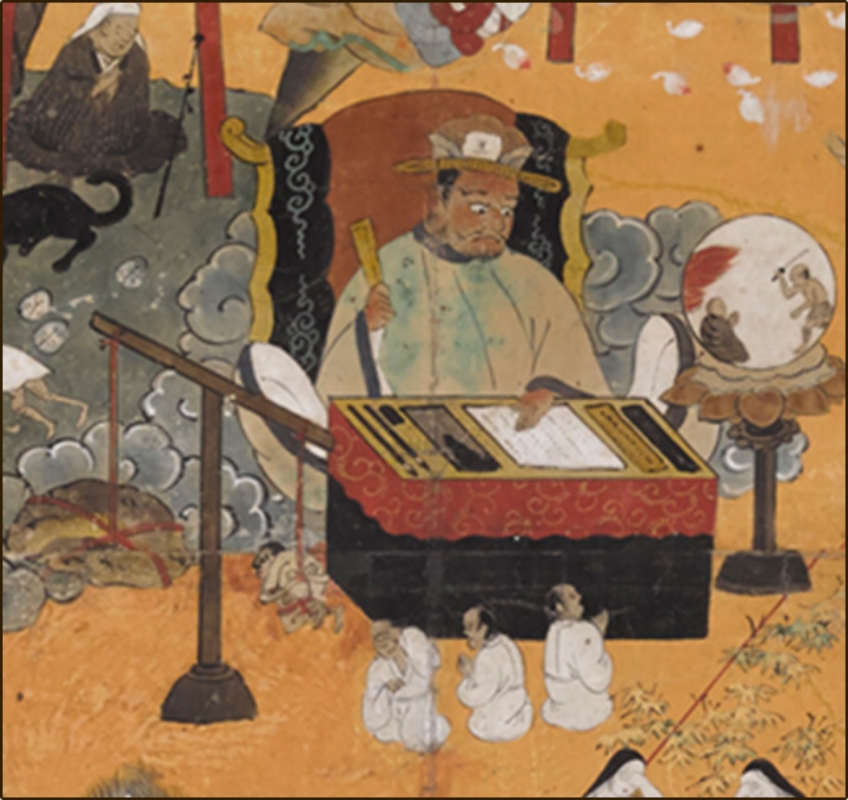
In Japan, people have traditionally believed that their destination after death would be determined through judgment by ten kings, as described in the apocryphal Sutra of the Ten Kings and the Sutra of Jizo and the Ten Kings. The painting depicts Enma (Yama-rāja), one of the Ten Kings of Hell, along with a mirror that shows the newly dead scenes of what they did when they were alive, and a scale used to determine the weight of people’s guilt. Enma appears in the story, along with some accoutrements such as a staff with a human head and the above-described mirror.
Ojoyoshu (Essentials of Rebirth in the Pure Land) gives detailed descriptions of eight great realms of Hell beneath the earth: the Hells of Repetition, of the Black Rope, of Assembly, of Lamentations, of Great Lamentations, of Scorching Heat, of the Great Scorching Heat, and of “No-Interval.” This painting depicts, surrounded by fire, some of the torments inflicted in the Hell of Assembly, such as a mountain of thorns and the dead souls being placed in an iron mortar and ground with an iron pestle, and being boiled in a cauldron. The story includes some of the torments from the Hell of Repetition, which closely resemble various cooking procedures.
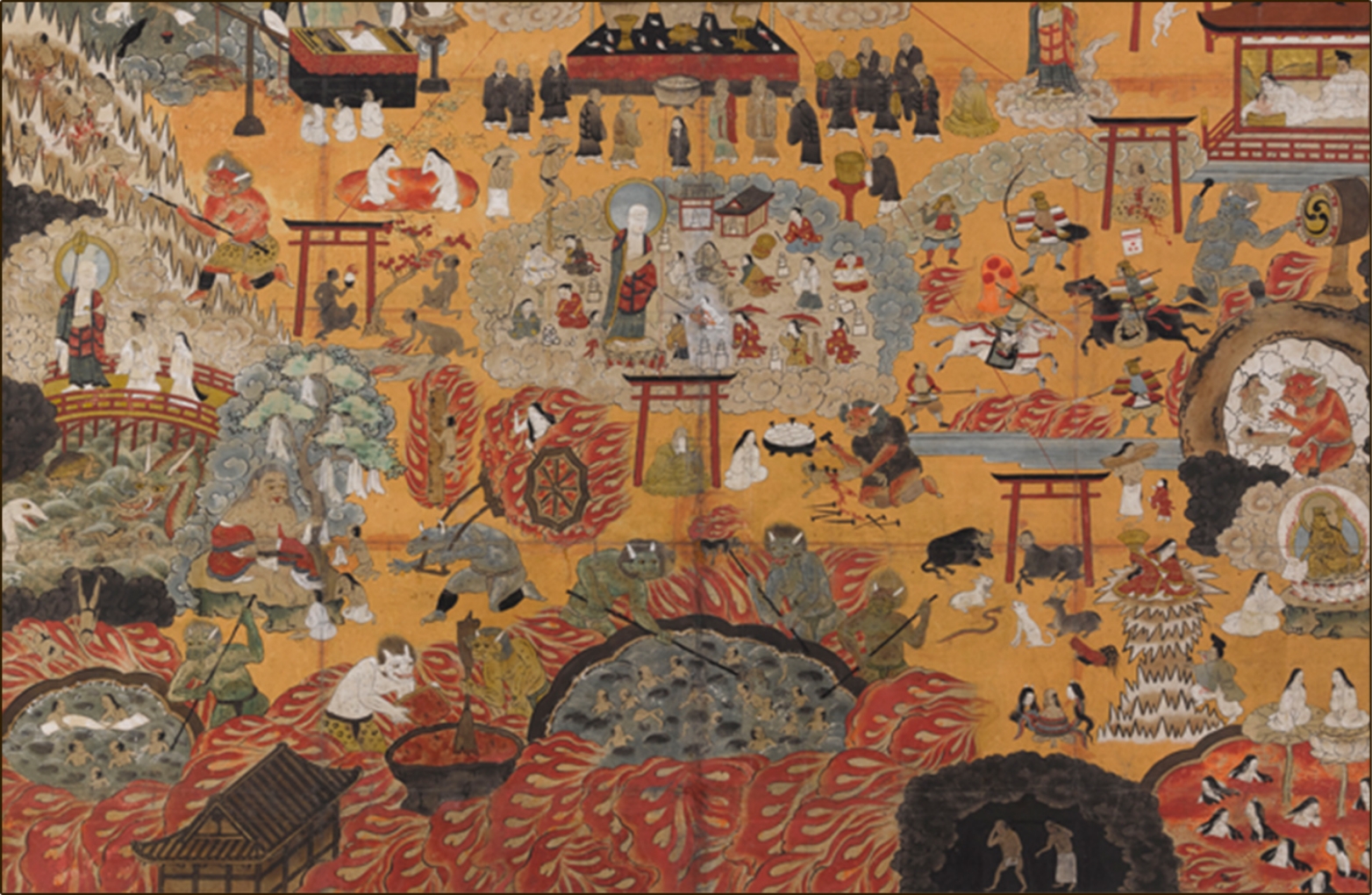
There is a story that tells of Maudgalyāyana (known in Japan as Mokuren), one of the Buddha’s close disciples, learning from Gautama Buddha how to obtain liberation for his mother, who had been reborn into the Realm of Hungry Ghosts, by making offerings in a spirit of filial piety (ullambana, the origin of the Japanese Obon festival), and succeeding in liberating her. The Buddhist “Tale of Mokuren” adds to and changes the story, so that his mother had fallen into the Hell of the Black Rope and was being boiled in a cauldron. This painting depicts Mokuren’s mother, pulled up out of the infernal cauldron, and the disciple himself wiping away tears, in a manner very similar to “The Tale of Mokuren.” It also shows the disciple learning the means of salvation from Gautama, and an Ullambana (Ghost Festival, precursor to the Japanese Bon Festival) gathering, and a central theme of the painting is salvation from the Six Realms (especially the lower “bad realms” of Hell, Hungry Ghosts, and Animals). The story describes Maya taking pity on Mokuren and his mother and intending to negotiate with Enma, King of Hell on their behalf, but in the end it appears she need not have worried.
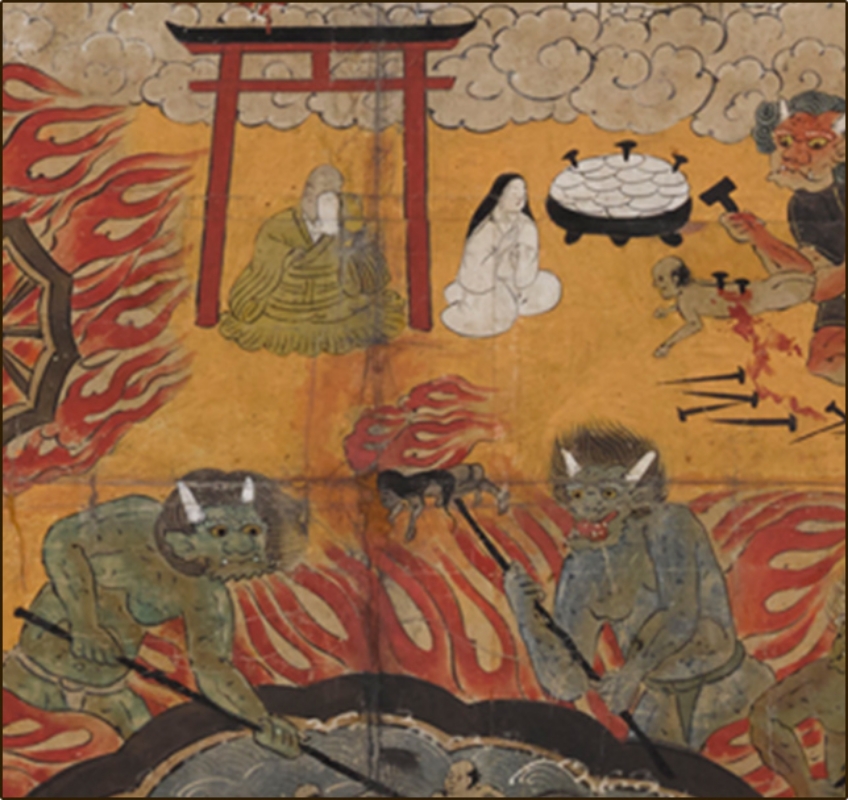
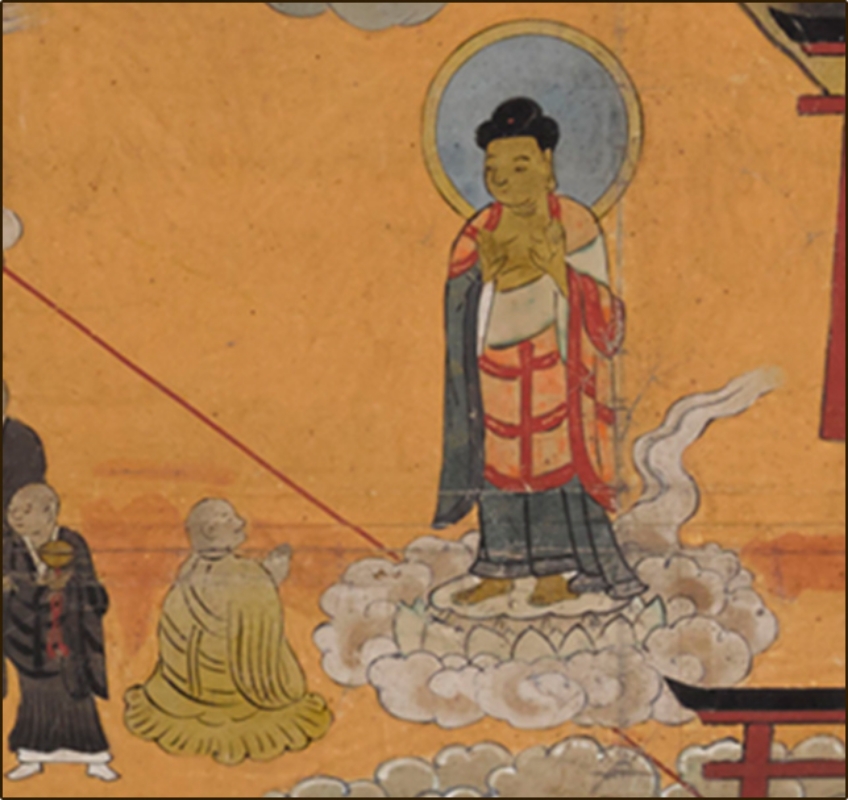
Chapter 6 The Sanzu Riverbank
The banks of the Sanzu River mean the Children’s Limbo. The Sanzu Riverbank is not described in sutras, and appear to be an indigenous Japanese concept. However, the second chapter of the Lotus Sutra states that “even children in play who made buddha stupas out of heaps of sand … have certainly attained the path of the buddhas,” and this image has often been depicted in Japanese art as children building towers of pebbles on a riverbank. Thus the scene on the Sanzu River banks may be based on the passage from the Lotus Sutra. The children piling up stones, and the figure of the bodhisattva Jizo holding a monk’s staff, appear in this painting as well. The story also describes demons that appear in the Hymn to Jizo and elsewhere.
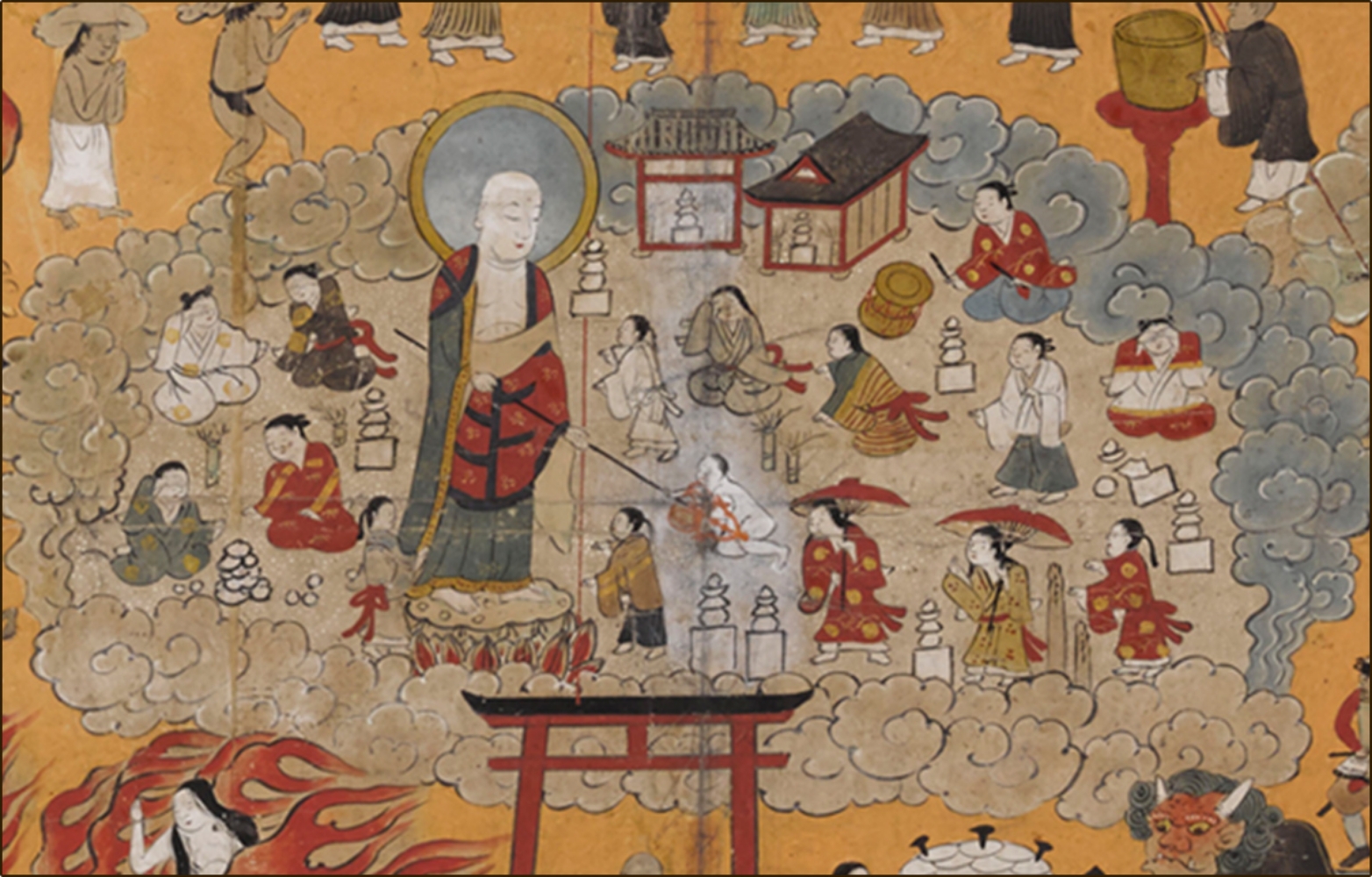
Chapter 7 Raigo (Descent of Amida)
In recent years, it has come to be believed that the Kumano Ten-Worlds Mandala was used not only to encourage people to pray, but also as a tool for religious teaching. This painting depicts “Buddha,” one of the ten worlds, in the form of the celestial Amitābha Buddha (known in Japan as Amida Nyorai) coming to welcome the spirits of the newly deceased with four bodhisattvas including Kannon (Avalokitesvara) and Seishi (Mahāsthāmaprāpta). When compared to the image of Gautama Buddha speaking with his disciple Maudgalyāyana (known in Japan as Mokuren), it is a more powerful representation of prayers for rebirth in the Pure Land. The story also features a scene in which Amida Nyōrai comes to a nun reciting Buddhist invocations and invites her to the Pure Land.
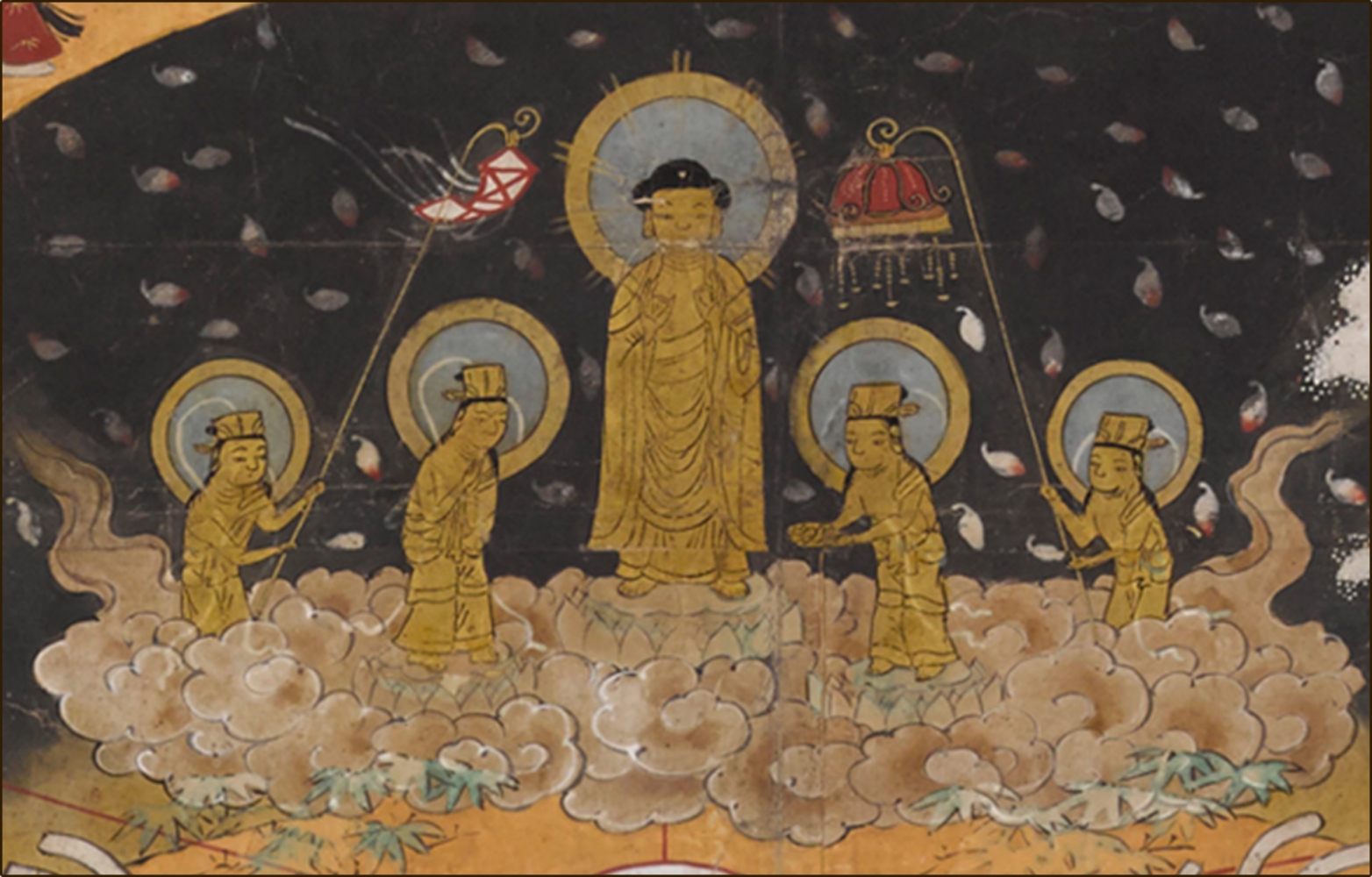


ここまでが本文です。
- TOP
- Digital Museum
- Maya's Journey Home
- MAYA’S WORLD
- Kumano kanshin jukkai zu (Kumano Ten-Worlds Mandala)


